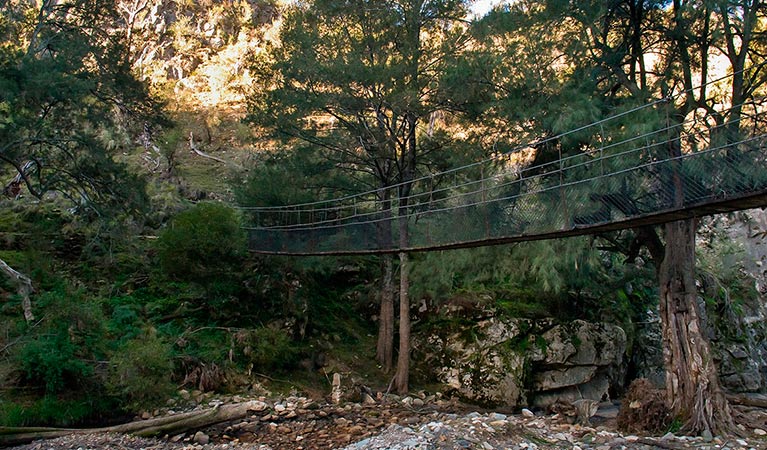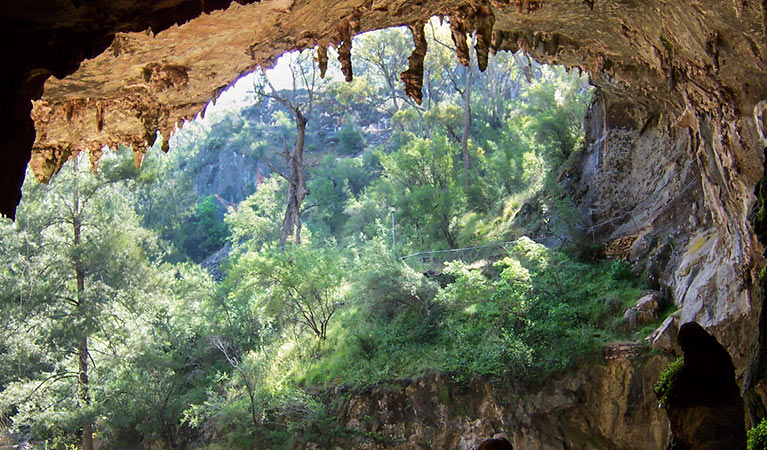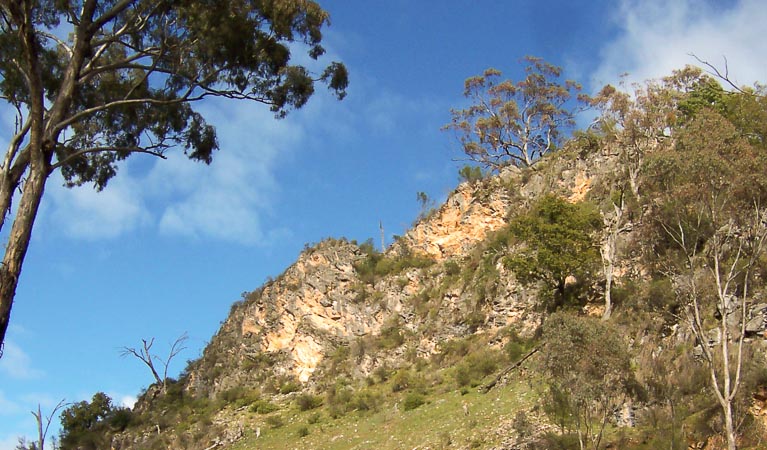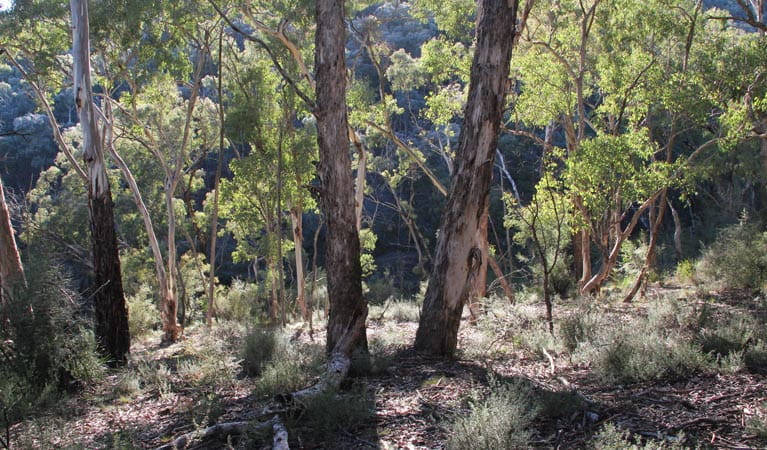Mount Gray walking track
Abercrombie Karst Conservation Reserve
Overview
Mount Gray walking track, near Abercrombie Caves, is a bushwalk to the relics of a historic mining site. It continues on to the magnificent waterfalls and scenic views at Grove Creek Falls.
- Distance
- 7km loop
- Time suggested
- 3 - 4hrs
- Grade
- Grade 4
- Trip Intention Form
-
It's a good idea to let someone know where you're going. Fill in a trip intention form to send important details about your trip to your emergency contact.
- Please note
- There's no drinking water available so you'll need to enough water for your trip.
- If you’re bushwalking in this park it’s a good idea to bring a topographic map and compass, or a GPS.
- There is no mobile reception in this park.
- It’s a good idea to put sunscreen on before you set out and remember to take a hat.
Take a journey back in time on Mount Gray walking track, when hopeful gold miners braved the remote bush conditions in their quest for fortune.
You’ll wander through undulating bushland on this medium grade walk to visit the place of a gold-mining community from the 1880s, listed on the National Estate as a historic heritage site.
The machinery and buildings have long-since gone, but the remaining earthworks are a reminder of the past. It was the miners from Mount Gray who built the dance platform inside the Abercrombie Archway at Abercrombie Caves.
After exploring this historic site, the walk leads down the road to the magnificent Grove Creek Falls. Stand at the lookout and watch the waterfalls of Grove Creek tumble over a sheer cliff to the ravine, 70 metres below.
Map

Map

Map legend

Local alerts
For the latest updates on fires, closures and other alerts in this area, see https://www.nationalparks.nsw.gov.au/things-to-do/walking-tracks/mount-gray-walking-track/local-alerts
General enquiries
- National Parks Contact Centre
- 7am to 7pm daily
- 1300 072 757 (13000 PARKS) for the cost of a local call within Australia excluding mobiles
- parks.info@environment.nsw.gov.au
Park info
- in Abercrombie Karst Conservation Reserve in the Country NSW region
Abercrombie Karst Conservation Reserve and caves are open Thursday to Monday (closed Tuesday and Wednesday). The reserve and caves area open daily during NSW school holidays. Closed Christmas Day.
Visitor info
All the practical information you need to know about Mount Gray walking track.
Track grading
Features of this track
Distance
7km loop
Time
3 - 4hrs
Quality of markings
Sign posted
Experience required
Some bushwalking experience recommended
Gradient
Very steep
Steps
Occasional steps
Quality of path
Rough track, many obstacles
Getting there and parking
Get driving directions
On entering Abercrombie Karst Conservation Reserve:
- Follow Cave Road until you get to the visitor centre
- Check local signage for directions to Mount Gray walking track
Road quality
Check the weather before you set out as the road to Mount Gray walking track can become boggy when it rains.
Parking
Parking is available at Mount Gray walking track.
Best times to visit
There are lots of great things waiting for you in Abercrombie Karst Conservation Reserve. Here are some of the highlights.
Autumn
Enjoy the cosy rooms and open fireplace at Arch Cottage and breathe in the crisp autumn air.
Spring
Pack a picnic and head off on Grove Creek Falls walking track for a relaxing lunch with spectacular views of the waterfalls.
Summer
Step out of your tent and go for a refreshing swim in the pools of Grove Creek, then discover the natural wonders underground on a cave tour.
Winter
Explore the historic mining site at Mount Gray by day, then get cosy by the campfire at night.
Weather, temperature and rainfall
Summer temperature
Average
8°C and 27°C
Highest recorded
27°C
Winter temperature
Average
-0.1°C and 12°C
Lowest recorded
-1.1°C
Rainfall
Wettest month
January
Driest month
April
The area’s highest recorded rainfall in one day
268.4mm
Maps and downloads
Prohibited
Pets
Pets and domestic animals (other than certified assistance animals) are not permitted. Find out which regional parks allow dog walking and see the pets in parks policy for more information.
Smoking
NSW national parks are no smoking areas.
Learn more
Mount Gray walking track is in Abercrombie Karst Conservation Reserve. Here are just some of the reasons why this park is special:
Bushrangers

In 1830 armed settlers, mounted police, and an army regiment fought it out with the Ribbon Gang near the caves. Ralph Entwistle, a convict servant, led a rebellion of convicts at Bathurst. His gang became known as 'The Ribbon Gang' because many of its members were said to have worn white ribbons in their hats.
- Mount Gray walking track Mount Gray walking track, near Abercrombie Caves, is a bushwalk to the relics of a historic mining site. It continues on to the magnificent waterfalls and scenic views at Grove Creek Falls.
Caves of time

Abercrombie Caves and the surrounding area is part of the traditional country of the Burra Burra group, who are part of the larger Wiradjuri tribe. The Burra Burra group knew about the caves, although no Aboriginal artifacts have been found in Arch Cave itself. However, in 1977 a research team found stone tools and animal bones, inlcuding some from extinct animals, in a shelter north of the Great Arch.
Natural wonders

The natural wonders of Abercrombie Karst Conservation Reserve will inspire you. Rare plant species such as laurel-leaf grevilleas and Chalker's wattle brighten the area with vibrant shades of yellow and red. Lucky visitors may also catch a glimpse of wildlife such as vulnerable peregrine falcons and sugar gliders lurking through the trees. Wallabies are also known to call Abercrombie Karst Conservation Reserve home, so be sure to keep an eye out.
Underground wonders

As early as 1821, the Sydney Gazette reported that 'a cave of considerable dimensions has been recently discovered in the neighbourhood of Bathurst'. There's no wonder that almost 200 years later the caves attract visitors from far and wide. The famous Arch Cave is 221 metres long, 60 metres wide at both ends and 30 metres high in the middle. It's considered the largest cave of its type in the southern hemisphere. Join a cave tour and discover the incredible natural world underground.
- Grove Creek Falls walking track Grove Creek Falls is a must-see for visitors to the Abercrombie Caves area. This walking track offers magnificent waterfalls, bushwalking and picnicking.
Plants and animals protected in this park
Animals
-

Eastern bentwing-bat (Miniopterus schreibersii oceanensis)
Eastern bentwing-bats congregate in caves across the east and north-west coasts of Australia, in colonies of up to 150,000. These small Australian animals weigh around 13-17g and can reach speeds of up to 50km per hour. Eastern bentwing-bats use both sight and echolocation to catch small insects mid-air.
-

Swamp wallaby (Wallabia bicolor)
The swamp wallaby, also known as the black wallaby or black pademelon, lives in the dense understorey of rainforests, woodlands and dry sclerophyll forest along eastern Australia. This unique Australian macropod has a dark black-grey coat with a distinctive light-coloured cheek stripe.
-

Kookaburra (Dacelo novaeguineae)
Of the 2 species of kookaburra found in Australia, the laughing kookaburra is the best-known and the largest of the native kingfishers. With its distinctive riotous call, the laughing kookaburra is commonly heard in open woodlands and forests throughout NSW national parks, making these ideal spots for bird watching.
-

Superb lyrebird (Menura novaehollandiae)
With a complex mimicking call and an elaborate courtship dance to match, the superb lyrebird is one of the most spectacular Australian animals. A bird watching must-see, the superb lyrebird can be found in rainforests and wet woodlands across eastern NSW and Victoria.

